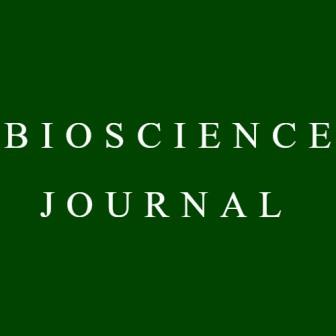Use of computational intelligence in the genetic divergence of colored cotton plants
DOI:
https://doi.org/10.14393/BJ-v37n0a2021-53634Palavras-chave:
Gossypium hirsutum, Kohonen Self-Organizing Maps, Neural NetworksResumo
The objective of this work was to analyze the genetic diversity using conventional methods and artificial neural networks among 12 colored fiber cotton genotypes, using technological characteristics of the fiber and productivity in terms of cottonseed and cotton fiber yield. The experiment was conducted in an experimental area located at Fazenda Capim Branco, belonging to the Federal University of Uberlândia, in the city of Uberlândia, Minas Gerais. Twelve genotypes of colored fiber cotton were evaluated, 10 from the Cotton Genetic Improvement Program (PROMALG): UFUJP - 01, UFUJP - 02, UFUJP - 05, UFUJP - 08, UFUJP - 09, UFUJP - 10, UFUJP - 11, UFUJP - 13, UFUJP - 16, UFUJP - 17 and two commercial cultivars: BRS Rubi (RC) and BRS Topázio (TC). The experimental design used was complete randomized block (CRB) with three replications. The following evaluations were carried out at full maturation: yield of cottonseed (kg ha-1) and the technological characteristics, which include, fiber length, micronaire, maturation, length uniformity, short fiber index, elongation and strength, using the HVI (High volume instrument) device. Genetic dissimilarity was measured using the generalized Mahalanobis distance and after obtaining the dissimilarity matrix, the genotypes were grouped using a hierarchical clustering method (UPGMA). A discriminant analysis and the Kohonen Self-Organizing Map (SOM) by Artificial Neural Networks (ANN’s) were performed through computational intelligence. SOM was able to detect differences and organize the similarities between accesses in a more coherent way, forming a larger number of groups, when compared to the method that uses the Mahalanobis matrix. It was also more accurate than the discriminant analysis, since it made it possible to differentiate groups more coherently when comparing their phenotypic behavior. The methods that use computational intelligence proved to be more efficient in detecting similarity, with Kohonen's Self-Organizing Map being the most adequate to classify and group cotton genotypes.
Downloads
Referências
ASSOCIAÇÃO BRASILEIRA DOS PRODUTORES DE ALGODÃO (ABRAPA). Algodão no mundo. Available from: https://www.abrapa.com.br/Paginas/dados/algodao-no-mundo.aspx.
BHERING, L.L., et al. Application of neural networks to predict volume in eucalyptus. Crop Breeding and Applied Biotechnology. 2015, 15, 125-131. https://doi.org/10.1590/1984-70332015v15n3a23
BORÉM, A. and FREIRE, E.C. Algodão: do plantio a colheita. 1th ed. Viçosa: UFV, 2014.
BRAGA, A.P., CARVALHO, A.C.L.F. and LUDEMIR, T.B. Redes Neurais Artificias: Teoria e aplicações. 2th ed. Rio de Janeiro: LTC, 2011.
CARDOSO, D.B.O., et al. Colored fiber cotton in the Uberlândia region using artificial neural networks for yield assessment. Genetics and Molecular Research. 2019, 18(1), 13. https://doi.org/10.4238/gmr18104
CRUZ, C.D. Genes Software: extended and integrated with the R, Matlab and Selegen. Acta Scientiarum Agronomy. 2016, 38(4), 547-552. https://doi.org/10.4025/actasciagron.v38i4.32629
CRUZ, C.D., REGAZZI, A.J. and CARNEIRO, P.C.S. Modelos biométricos aplicados ao melhoramento genético. 3th ed. Viçosa: UFV, 2014.
CRUZ, C. D. and NASCIMENTO, M. Inteligência computacional aplicada ao melhoramento genético. 1th ed. Viçosa: UFV, 2018.
DUTT, Y., et al. Breeding for high yield and quality in colored cotton. Plant Breeding. 2008, 123(1), 145-151. https://doi:%2010.1046/j.1439-0523.2003.00938.x
HU, Z., ZHAO, Q. and WANG, J. The Prediction Model of Cotton Yarn Quality Based on Artificial Recurrent Neural Network. In International Conference on Applications and Techniques in Cyber Security and Intelligence. 2019, 1017, 857-866. Springer, Cham. https://doi.org/10.1007/978-3-030-25128-4_105
MIRANDA, M.C.C. Diversidade genética entre genótipos de algodoeiro visando ampliação da variabilidade. Uberlândia: Universidade Federal de Uberlândia, 2019. Available from: https://repositorio.ufu.br/handle/123456789/24947
NARDINO, M., et al. Genetic divergence among corn (Zea mays L.) genotypes in distinct environments. Revista de Ciências Agrárias. 2017, 40(1), 164-174. https://doi.org/10.19084/RCA16013
OLIVEIRA, A.C.L., et al. Use of mathematical modeling (artificial neural networks) in classification of banana autotetraploid (Musa acuminata colla). Bioscience Journal. 2013, 29(3), 617-622, 2013.
RODRIGO, S.E., LESCANO, C.N. and RODRIGO, R.H. Application of Kohonen maps to kinetic analysis of human gait. Revista Brasileira de Engenharia Biomédica. 2012, 28(3), 217-226. https://doi.org/10.4322/rbeb.2012.027
SILVA, P.C.D. Divergência genética entre linhagens parcialmente endogâmicas de milho pipoca por métodos multivariados e redes neurais artificiais. Uberlândia: Universidade Federal da Grande Dourados, 2018. Available from: http://repositorio.ufgd.edu.br/jspui/handle/prefix/1032
Downloads
Publicado
Como Citar
Edição
Seção
Licença
Copyright (c) 2021 Daniel Bonifácio Oliveira Cardoso, Luiza Amaral Medeiros, Gabriela de Oliveira Carvalho, Izabela Motta Pimentel, Gabriella Xavier Rojas, Lara Araujo Sousa, Gabriel Medeiros Souza, Larissa Barbosa de Sousa

Este trabalho está licenciado sob uma licença Creative Commons Attribution 4.0 International License.






